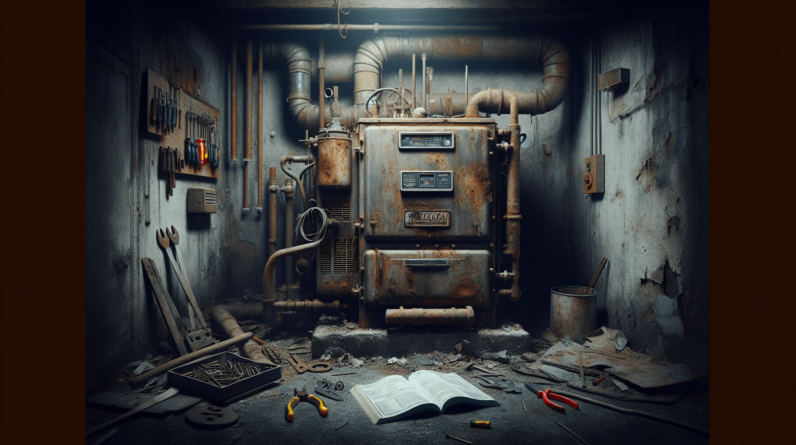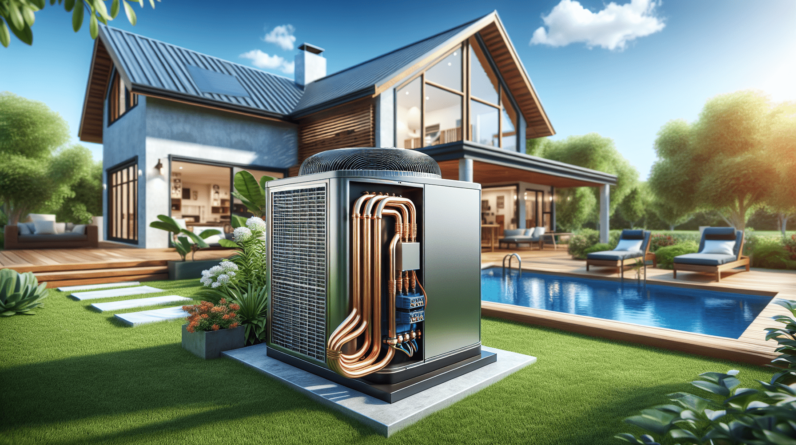
So, you’re sitting at home and suddenly you notice a pool of water forming on the floor. Panic sets in as you realize there might be a burst pipe somewhere. But how can you be sure? In this article, we’ll explore the telltale signs that indicate a pipe has burst. From water damage to strange noises, we’ll cover it all, providing you with the knowledge to identify this common household issue and take the necessary steps to resolve it. Don’t fret, my friend, help is on the way!
Signs of a Burst Pipe
When a pipe bursts in your home, there are several signs that can indicate this unfortunate event. Recognizing these signs early on can help you quickly address the issue, minimize the damage, and prevent further complications. Here are some common signs of a burst pipe:
Water Damage
One of the most noticeable signs of a burst pipe is water damage. If you observe any water stains on your walls, ceilings, or floors, it’s a strong indicator that there is a leak somewhere in your plumbing system. Keep an eye out for discoloration or dampness, as these are clear indications of water intrusion.
Decreased Water Pressure
Another sign to watch out for is decreased water pressure. If you’ve noticed a significant drop in water pressure throughout your home, especially in multiple fixtures, it could be a result of a burst pipe. A compromised pipe will disrupt the normal flow of water, leading to reduced pressure.
Strange Smells
Unpleasant odors can also be a sign of a burst pipe. If you detect a sewage odor or a musty and damp smell in your home, it may indicate that a pipe has burst and is leaking wastewater. These odors can be quite overpowering and are often difficult to ignore.
Unusual Sounds
Unusual sounds coming from your plumbing system can also be indicative of a burst pipe. If you hear hissing or whistling noises, it could be a sign of a pressured water leak. Similarly, banging or thumping sounds may occur if a pipe is ruptured and the water is hitting against other surfaces. Continuous running water or dripping/leaking sounds are also signs to look out for.
Checking for Water Damage
Once you suspect that a pipe has burst, it’s crucial to check for water damage to assess the severity of the situation. Here are some key areas to inspect:
Visible Water Stains
Inspect all walls, ceilings, and floors for visible water stains. These stains can appear as discoloration or dark patches, indicating where water has leaked and caused damage. Take note of any stains you find as they can help pinpoint the location of the burst pipe.
Warping or Bubbling Paint or Wallpaper
When water seeps into walls, it can cause the paint or wallpaper to warp or bubble. This is a clear sign of water damage and should not be ignored. If you notice any abnormalities in your walls, it’s a good indication that a burst pipe is causing the issue.
Damp or Wet Carpets
Check your carpets or flooring for any dampness or wetness. A burst pipe can lead to water seeping into the floor, saturating the carpet or causing other types of flooring to become wet. If your feet feel damp or you notice a moist sensation when walking on the carpet, it’s likely due to a burst pipe.
Mold or Mildew Growth
The presence of mold or mildew in your home is a strong indicator of water damage, often caused by a burst pipe. Mold and mildew thrive in damp environments, and if you notice any black spots, musty smell, or peeling paint on walls, it could point towards a burst pipe that needs attention.
Testing Water Pressure
To further confirm if a pipe has burst, you can perform a simple test to check the water pressure throughout your home. Follow these steps to evaluate the water pressure:
Turn on Faucets
Start by turning on all the faucets in your home, including those in the kitchen, bathrooms, and utility rooms. Take note of the water flow and any irregularities you notice.
Check Water Flow
Observe the water flow from each faucet. If you notice a significant decrease in water pressure or irregular spurts of water, it may suggest a burst pipe somewhere in the plumbing system.
Evaluate Multiple Fixtures
Continue the evaluation by checking the water pressure in different fixtures simultaneously. Turn on the shower, flush the toilets, and run the dishwasher or washing machine. If multiple fixtures exhibit reduced water pressure simultaneously, it’s a strong indication of a burst pipe.
Identifying Strange Smells
In addition to physical signs, peculiar odors can also help identify a burst pipe. Here are two distinct smells to be aware of:
Sewage Odor
If you detect a strong sewage odor in your home, it could indicate a burst pipe connected to your sewer line. The smell may arise from leaking wastewater, which poses health risks and requires immediate attention from a professional plumber.
Musty or Damp Odor
A musty or damp smell can be an indicator of water damage caused by a burst pipe. When hidden leaks are left untreated, it creates an ideal environment for mold and mildew growth. These fungi emit a distinct odor, often described as musty or damp.
Listening for Unusual Sounds
By actively listening for unusual sounds, you can gather additional clues to confirm a burst pipe. Here are some sounds to pay attention to:

Hissing or Whistling
If you hear hissing or whistling sounds, it suggests a pressured water leak through a burst pipe. These sounds typically occur when water escapes forcefully from a compromised pipe and creates turbulence in the plumbing system.
Banging or Thumping
Another auditory sign of a burst pipe is banging or thumping sounds. When a pipe bursts, the water flow can cause the remaining pipes or adjacent surfaces to vibrate or bang against each other. These noises can be disturbing and require immediate attention.
Continuous Running Water
Hearing the sound of running water even when no fixtures are in use can be an indication of a burst pipe. A constant flow of water indicates an underlying leak in the plumbing system that must be addressed promptly to prevent further damage.
Dripping or Leaking Sounds
If you notice dripping or leaking sounds coming from areas where there shouldn’t be any, it is likely the result of a burst pipe. The sound of water dripping or leaking can be audible inside walls, ceilings, or floors, indicating that water is escaping from a damaged pipe.
Locating the Burst Pipe
Once you have identified the signs and have a strong suspicion of a burst pipe, it’s essential to locate the exact area of the damage for effective repair. Here is how you can pinpoint the burst pipe:
Isolating Affected Area
Based on the signs you’ve observed, try to narrow down the affected area in your home. Determine which sections have experienced water damage, reduced water pressure, or unusual sounds. This step helps in focusing your inspection efforts.
Checking Exposed Pipes
Inspect any exposed pipes in your home, such as those underneath sinks, in the basement, or utility rooms. Look for visible signs of leakage, such as water dripping or stains around the pipe joints. These areas are more prone to burst pipes and should be checked thoroughly.
Examining Basement or Crawl Space
If your home has a basement or crawl space, check for any signs of water damage, such as pools of water or wet areas on the ground. Burst pipes often affect these areas due to temperature fluctuations and poor insulation. Carefully examine the pipes in these locations for any signs of leakage.
Inspecting Attic or Ceiling
In some cases, burst pipes can affect the attic or ceilings. Look for signs of water damage on the ceiling, such as discoloration, peeling paint, or sagging. Check the pipes running through these areas to determine if they are the source of the problem.
Turning Off the Water Supply
Before any repair or further assessment can take place, it’s crucial to turn off the water supply to prevent more water damage from occurring. Here’s what you need to do:
Locating Main Water Valve
Locate your main water valve, which is typically situated near the water meter or where the main water line enters your home. Often, this valve is located in the basement, utility room, or near the front of the house. Familiarize yourself with its location before a burst pipe emergency arises.
Shutting Off Water Supply
Once you have located the main water valve, turn it off by rotating it clockwise. This action will shut off the water supply to your entire home, stopping any further water flow from the burst pipe. It’s essential to act quickly to minimize water damage and avoid wasting excessive amounts of water.
Calling a Professional Plumber
While you may be tempted to fix a burst pipe yourself, it is highly recommended to call a professional plumber. Such situations require technical expertise and specialized equipment. Here are a few reasons why you should rely on a professional:
Reasons to Call a Plumber
Firstly, a professional plumber has the knowledge and experience to accurately diagnose and repair burst pipes. They can identify the root cause of the problem and implement effective solutions. Additionally, hiring a plumber ensures that the repair is carried out safely and in compliance with any local regulations.
Professional Repair or Replacement
Attempting a DIY repair on a burst pipe can lead to further damage or incomplete repairs, prolonging the issue. A professional plumber can quickly assess the damage, recommend the necessary repairs, and potentially replace the burst pipe if needed. They have the necessary tools and equipment to restore your plumbing system efficiently.
Dealing with an Emergency Situation
In certain cases, a burst pipe can lead to an emergency situation that requires immediate action. Here’s how to handle the situation promptly and effectively:
Contain Water Damage
Once you’ve turned off the water supply, focus on containing the water damage. Place buckets or containers to collect any dripping water. If there are any wet or damp items, remove them from the affected area to prevent further damage to your belongings.
Turn Off Electricity
To ensure safety, turn off the electricity supply to the affected area. Water and electricity can be a dangerous combination, so it’s crucial to eliminate the risk of electrical shock or short circuits. Locate your electrical panel and switch off the circuit breakers corresponding to the affected area.
Contact Insurance Company
Contact your insurance company as soon as possible to report the burst pipe and discuss potential coverage for water damage restoration. They can guide you through the claims process and provide advice on what steps to take next. Document the extent of the damage with photos and keep records of any related expenses.
Preventing Future Pipe Bursts
While burst pipes can be an unfortunate event, there are measures you can take to minimize the risk of it happening again in the future. Here are some preventive measures to consider:
Insulating Pipes
Properly insulating your pipes is a crucial step in preventing future burst pipes. By adding insulation to vulnerable areas, such as those in unheated spaces or exterior walls, you can protect them from freezing temperatures that can cause pipes to burst.
Maintaining Proper Heating
During colder months, maintaining a consistent and adequate indoor temperature is essential. Ensure that all areas of your home, including basements and attics, are properly heated to prevent pipes from freezing and bursting.
Draining Outdoor Faucets
Before winter arrives, disconnect and drain garden hoses and close the outdoor faucets properly. This step prevents water from freezing in the outdoor plumbing fixtures, which can lead to burst pipes.
Regularly Checking for Leaks
Perform regular checks for any signs of leaks or weak spots in your plumbing system. Inspect exposed pipes, fixtures, and appliance connections for any signs of water damage or corrosion. Detecting and repairing leaks promptly can prevent them from escalating into burst pipes.
In conclusion, recognizing the signs of a burst pipe is crucial for homeowners. By understanding what to look for and how to respond, you can minimize water damage, keep your home safe, and prevent future pipe bursts. If you suspect a burst pipe, don’t hesitate to contact a professional plumber for immediate assistance. Taking prompt action can help save time, money, and protect your property from further damage.






